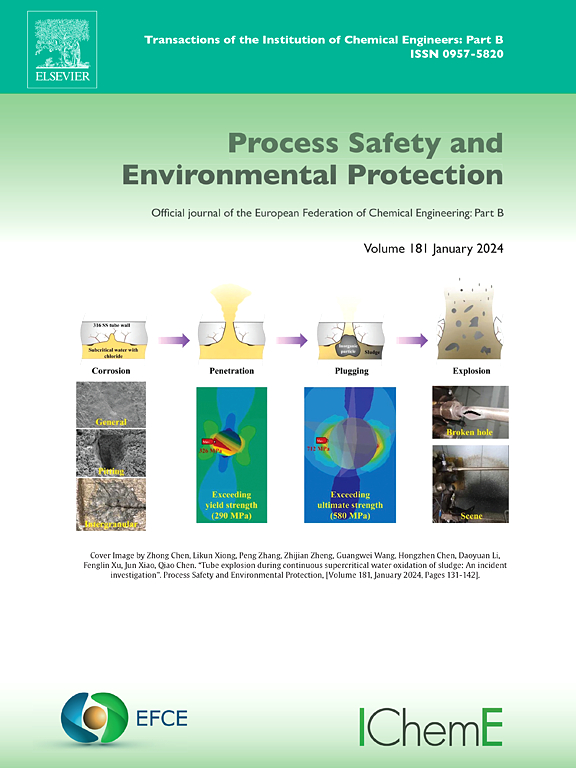Influence of nitrogen-boron-sulfur triple-doping on the fluorescence emission of carbon dots and their sensing detection of copper ions
IF 6.9
2区 环境科学与生态学
Q1 ENGINEERING, CHEMICAL
引用次数: 0
Abstract
This study used a one-step hydrothermal approach to synthesize three doped carbon dots, Cdots-1 (N-doped), Cdots-2 (N, S co-doped), and Cdots-3 (N, S, B co-doped), using aspartic acid, cysteine, and boric acid as raw ingredients. We employed XRD, TEM, Uv-Vis, XPS, FTIR, and PL techniques to characterize the morphology, elemental composition, and optical properties of samples. We found that doping is an effective way to control the core structure and emission properties of carbon dots. Among the three carbon dots, Cdots-3 has the highest fluorescence intensity and emits strong blue fluorescence. In addition, we found that Cdots-3 is highly responsive to Cu2 + with a linear equation of y = 955.02–1.68976x, which makes it a fluorescent probe that can detect Cu2+ rapidly. The fluorescence lifetime of Cdots-3 was shortened from 3.76 ns to 3.33 ns after adding Cu2+. The analysis shows that the fluorescence quenching of Cdots-3 is mainly a dynamic quenching mechanism accompanied by a standard static quenching process. Moreover, to verify the detection accuracy of the experiment, we used the linear regression model, random forest regression model, support vector machine regression model, and decision tree regression model to predict the detection model, respectively. Among them, the random forest model has the best prediction effect. The coefficient of determination reaches 0.9996, and the mean square error is 0.0167. It is suggested that Cdots can be used as fluorescent probes to detect the reliability of Cu2+.
氮硼硫三掺杂对碳点荧光发射及对铜离子的传感检测的影响
本研究以天冬氨酸、半胱氨酸和硼酸为原料,采用一步水热法合成了三种掺杂碳点,分别是cdot -1 (N掺杂)、cdot -2 (N、S共掺杂)和cdot -3 (N、S、B共掺杂)。我们采用XRD, TEM, Uv-Vis, XPS, FTIR和PL技术表征了样品的形貌,元素组成和光学性质。我们发现掺杂是控制碳点核心结构和发射性能的有效方法。三个碳点中,Cdots-3的荧光强度最高,发出较强的蓝色荧光。此外,我们发现Cdots-3对Cu2 +具有高响应性,线性方程为y = 955.02-1.68976x,是一种能够快速检测Cu2+的荧光探针。加入Cu2+后,Cdots-3的荧光寿命由3.76 ns缩短至3.33 ns。分析表明,Cdots-3的荧光猝灭主要是动态猝灭机制,同时伴有标准的静态猝灭过程。此外,为了验证实验的检测精度,我们分别使用线性回归模型、随机森林回归模型、支持向量机回归模型和决策树回归模型对检测模型进行预测。其中,随机森林模型的预测效果最好。判定系数达到0.9996,均方误差为0.0167。这表明Cdots可以作为荧光探针来检测Cu2+的可靠性。
本文章由计算机程序翻译,如有差异,请以英文原文为准。
求助全文
约1分钟内获得全文
求助全文
来源期刊

Process Safety and Environmental Protection
环境科学-工程:化工
CiteScore
11.40
自引率
15.40%
发文量
929
审稿时长
8.0 months
期刊介绍:
The Process Safety and Environmental Protection (PSEP) journal is a leading international publication that focuses on the publication of high-quality, original research papers in the field of engineering, specifically those related to the safety of industrial processes and environmental protection. The journal encourages submissions that present new developments in safety and environmental aspects, particularly those that show how research findings can be applied in process engineering design and practice.
PSEP is particularly interested in research that brings fresh perspectives to established engineering principles, identifies unsolved problems, or suggests directions for future research. The journal also values contributions that push the boundaries of traditional engineering and welcomes multidisciplinary papers.
PSEP's articles are abstracted and indexed by a range of databases and services, which helps to ensure that the journal's research is accessible and recognized in the academic and professional communities. These databases include ANTE, Chemical Abstracts, Chemical Hazards in Industry, Current Contents, Elsevier Engineering Information database, Pascal Francis, Web of Science, Scopus, Engineering Information Database EnCompass LIT (Elsevier), and INSPEC. This wide coverage facilitates the dissemination of the journal's content to a global audience interested in process safety and environmental engineering.
 求助内容:
求助内容: 应助结果提醒方式:
应助结果提醒方式:


